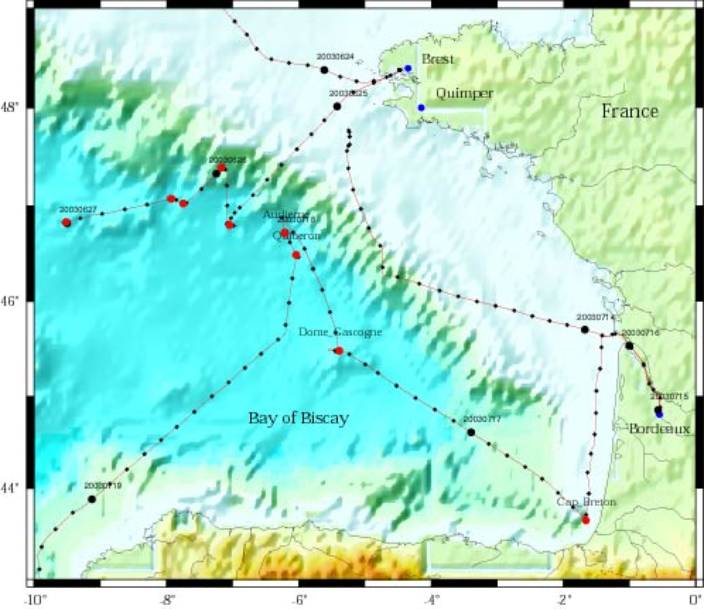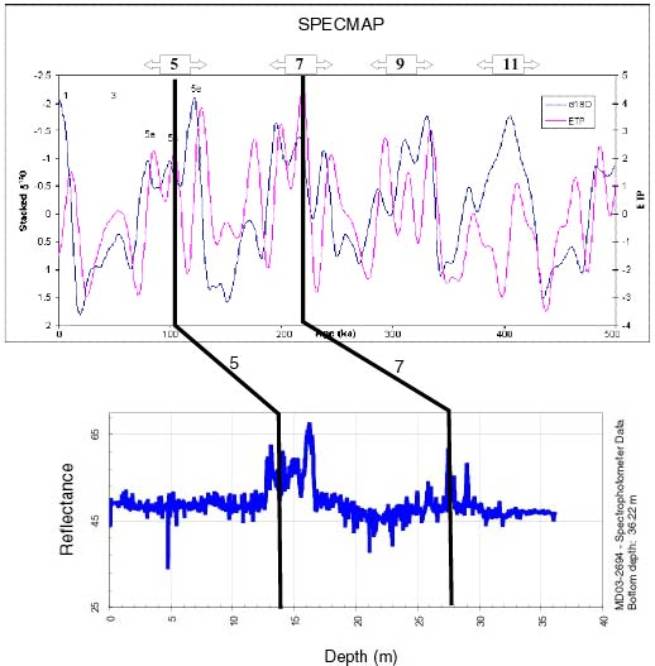Scientific Objectives:
The Bay of Biscay
Main objectives
Research in the Bay of Biscay (see Figure 1) in July 2003, under the auspices of the SEDICAR mission, has three primary objectives. Two of these objectives are sedimentologic and include the analysis and dating of terraces located in the sub-marine canyon of Cap Breton as well as the determination of the provenance of dendritic sediment within the Audierne and Quiberon deep sea fan system: The third objective is paleoclimatic and is intended to correlate spectral data gathered from cores taken in the Dome Gascogne area with ice core O18 data for paleoclimatic study.

Figure 1: Map of the Bay of Biscay. Dotted black line represents proposed ship track while red dots indicate proposed core sites.
Description of the Bay of Biscay
In the Bay of Biscay, deep-sea canyons that have generally narrow, steep sided, linear and sinuous channels cut the continental slope. These deep-sea valleys permit continentally derived sediments to be transported to oceanic basins and deposited in deep-sea fans. Several processes linked to eustatic and / or tectonic movement could explain the incision of deep-sea canyons. Sedimentary process active in these deep-sea valleys include gravity driven (creeping, slumping, turbidity currents), and hemipelagic sedimentation that covers terraces. The portion of the SEDICAR mission within the Bay of Biscay will allow for the analysis of sub-marine canyons themselves as well as the fan systems at their distal reaches.
Sedimentological Objectives Methodology
The first Bay of Biscay objective is the analysis and dating of terraces located in deep-sea canyons like Cap Breton (see Figure 2). In order to achieve this objective, nine cores, each at an average of 30m length, have been extracted. After cutting and preparation, the cores are photographed and analysed using MST (Multi-Sensor Tracking) in order to measure magnetic susceptibility, p-wave speeds, and gamma densimetry of each core.

Figure 2: Bathymetric map of the Cap Breton sub-marine canyon (fig. JF Bourillet, IFREMER).
Paleoclimatic Objective Methodology
The first analysis in the core extracted in the Bay of Biscay (Dome of Gascogne) is based on the observation of color variations (dark and light laminations) due to variations in reflectance (see Figure 3). The dark parts correspond to cold periods and the light parts correspond to warm periods. This approach gives an idea of the different isotopic stages that we can observe in future studies.

Figure 3: Correlation of reflectance (lower graph) of Dome of Gascogne and reference ice core O18 data (upper graph).



